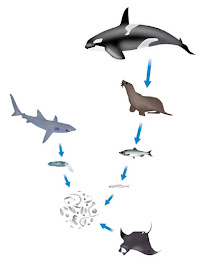Lesions or stimulation of the medial, dorsal, and anterior nuclei of the thalamus are associated with changes in emotional reactivity. However, the importance of these nuclei on the regulation of emotional behavior is not due to the thalamus itself, but to the connections of these nuclei with other limbic system structures.
The medial dorsal nucleus makes connections with cortical zones of the prefrontal area and with the hypothalamus. The anterior nuclei connect with the mamillary bodies and through them, via fornix, with the hippocampus and the cingulated gyrus, thus taking part in what is known as the Papez's circuit.
Tuesday, November 25, 2008
Tuesday, November 18, 2008
Nervous system
The nervous system is a network of specialized cells that communicate information about an animal's surroundings and itself. It processes this information and causes reactions in other parts of the body. It is composed of neurons and other specialized cells called glia, that aid in the function of the neurons. The nervous system is divided broadly into two categories; the peripheral nervous system and the central nervous system. Neurons generate and conduct impulses between and within the two systems.
The peripheral nervous system is composed of sensory neurons and the neurons that connect them to the nerve cord, spinal cord and brain, which make up the central nervous system. In response to stimuli, sensory neurons generate and propagate signals to the central nervous system which then processes and conducts signals back to the muscles and glands. The neurons of the nervous systems of animals are interconnected in complex arrangements and use electrochemical signals and neurotransmitters to transmit impulses from one neuron to the next.
The interaction of the different neurons form neural circuits that regulate an organism's perception of the world and what is going on with its body, thus regulating its behavior. Nervous systems are found in many multicellular animals but differ greatly in complexity between species
The peripheral nervous system is composed of sensory neurons and the neurons that connect them to the nerve cord, spinal cord and brain, which make up the central nervous system. In response to stimuli, sensory neurons generate and propagate signals to the central nervous system which then processes and conducts signals back to the muscles and glands. The neurons of the nervous systems of animals are interconnected in complex arrangements and use electrochemical signals and neurotransmitters to transmit impulses from one neuron to the next.
The interaction of the different neurons form neural circuits that regulate an organism's perception of the world and what is going on with its body, thus regulating its behavior. Nervous systems are found in many multicellular animals but differ greatly in complexity between species
Tuesday, November 11, 2008
Typography
Typography is the art, craft and techniques of type design, modifying type glyphs, and arranging type. Type glyphs (characters) are created and modified using a variety of illustration techniques. The arrangement of type is the selection of typefaces, point size, line length, leading (line spacing) and letter spacing.
Typography is performed by typesetters, compositors, typographers, graphic artists, art directors, and clerical workers. Until the Digital Age, typography was a specialized occupation. Digitization opened up typography to new generations of visual designers and lay users.
Typography is performed by typesetters, compositors, typographers, graphic artists, art directors, and clerical workers. Until the Digital Age, typography was a specialized occupation. Digitization opened up typography to new generations of visual designers and lay users.
Subscribe to:
Posts (Atom)



